Global Logistics Trends: Part 1 – Predictive Analytics
As the global logistics industry evolves, cost escalations are inevitable. To thrive amid such challenges, successful operators will have to find innovative ways to generate new revenue and create efficiencies. The global supply chain is undergoing significant changes driven by technological advancements and ever-evolving consumer expectations. Today’s consumers are increasingly relying on eCommerce for their purchases, demanding faster product deliveries, and expecting a high degree of transparency in the process.
Investments in cutting-edge technologies like data analytics and automation can help supply chain participants meet these expectations while fostering future growth. This four-part series discusses key trends that are reshaping the logistics space. This first installment focuses on the growing demand for predictive analytics.
Trend #1: The Surge in Demand for Predictive Analytics
Big data algorithms have ushered in an era of more intelligent analytics, leading to heightened efficiency, shorter delivery times, better accuracy, and improved customer satisfaction. Predictive analytics, a step above conventional data analysis, uses historical data to project various outcomes based on differing algorithms. This tool equips you and your customers with a comprehensive understanding of costs. It helps identify potential savings and determines the best outcomes considering delivery time and distance – crucial aspects of global shipping.
Predictive analytics also utilizes both internal and external data to foresee potential system breakdowns. By being proactive and implementing preemptive solutions, operators can prevent surprise interruptions in their workflow. This can also ensure that inventory levels are maintained optimally. By analyzing current disruptions to predict where risks may occur in the supply chain, operators can leverage predictive analytics as an early warning system, safeguarding against potential losses.

Key Takeaway and Action Step:
The surge in demand for predictive analytics underlines its critical role in the modern logistics industry. The ability to anticipate potential disruptions and make informed decisions based on historical data is more than just an operational advantage—it’s becoming a prerequisite for staying competitive.
As a crucial first step, businesses should begin assessing their current capabilities in predictive analytics. Identify the gaps and opportunities in your data management and consider whether your existing systems are capable of fully leveraging the power of predictive analytics.
Remember, adopting predictive analytics isn’t just about acquiring a new tool; it’s about fostering a data-driven culture within your organization. Encourage your team to embrace this technology, learn from the insights it provides, and continuously improve your operations based on the predictions it offers.
How Cadre Can Help
For those looking to take their operations to the next level, Cadre Technologies’ warehouse management software can offer a robust predictive analytics solution. Reach out to us today, and we’ll guide you on leveraging your data to drive operational efficiency and growth. Don’t wait until you’re reacting to disruptions. Use predictive analytics to stay ahead of them.
Stay tuned for next week as we delve into how emerging technologies are revolutionizing warehouse automation in the next part of this series!
Explore the Series Further
In case you want to delve deeper into the logistics trends, feel free to explore the other parts of our series:
Global Logistics Trends, Part 2: Automation, Robotics, Smart Glasses, and Drones
Global Logistics Trends, Part 3: Greater Data Transparency
Global Logistics Trends, Part 4: Navigating the Landscape of Instant Delivery









